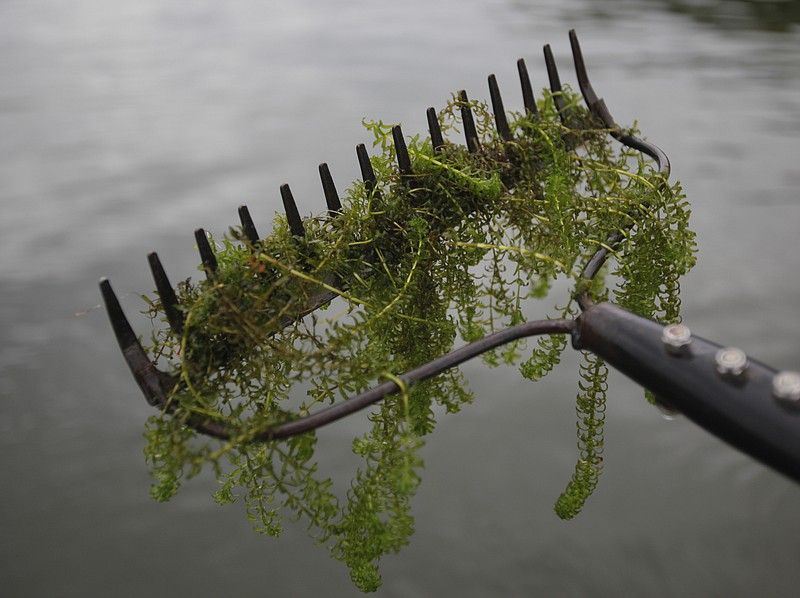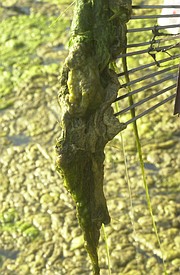IF YOU GO
What: Informational meeting on aquatic weed management on Watts Bar LakeWhere: Spring City Municipal Building meeting room, 229 Front St.When: 6 p.m. May 3Who: TVA aquatic plant management program director Brett Hartis
DON’T SPREAD A BAD THING
One step boaters and lake-users on the Tennessee River’s reservoirs can take to prevent the spread of non-native aquatic plants is to clean boats, trailers, floats and other equipment of any plant material — especially propellers, engine compartments and trailer running boards — before moving to another body of water. TVA experts say aquatic plants need only a little moisture and sunlight to remain viable for weeks.
SPRING CITY, Tenn. - By late summer, the water weeds are so thick you could almost walk on parts of Watts Bar Lake without getting wet.
Invasive aquatic plants that mass around boat docks on the Tennessee River are starting to grow and will begin to cause access problems by late May or June, said Gary Venice, a Spring City real estate broker, boater and lake user.
The worst offenders are Eurasian watermilfoil, especially hydrilla. The non-native species flourish in the Tennessee River because they have no native enemies, and they compete with native plant species for habitat.
Venice wants lakefront property owners on Watts Bar Lake to be informed about aquatic plants and what can be done to control them.
"It's kind of the general consensus that there's going to be - if left unchecked - as much as 20 percent of the lake in the next five to seven years that could be infested," he said recently.
"We have some world-class bass tournaments going on [like those on Chickamauga Lake] and that's not lost on me. Certainly there are areas where it may make sense for them to grow," Venice said. "There are ways to treat it and there's a lot of good information out there, but nobody has a handle on it."
Venice is worried frustrated homeowners could do something drastic and damaging in an attempt to clear their docks of weeds.
To dodge such a disaster, Venice said, his company, ERA BlueKey Properties Spring City, will host a meeting with an aquatic plants expert from the Tennessee Valley Authority who can help sort fact from fiction and work with homeowners, area associations and organizations to find a solution.
"There are all kinds of stakeholders," Venice said, specifically noting anglers, who he said should have input in control efforts. "Whatever approach we take, everybody needs to be involved and it needs to be equitable. I want a fair shake for everybody."
Venice believes education is the best first step.
Brett Hartis, program manager of TVA's Aquatic Plant Management Program, is the federal agency's foremost authority on aquatic plants. He's also an avid outdoorsman and bass angler, and he admits getting his bass boat stuck in the weeds at least once.
Hartis is known to some of his TVA colleagues as "Dr. Weed," TVA spokesman Scott Fiedler joked Friday.
"Not the Colorado type of weed," Fiedler said. "He has a Ph.D. in aquatic plant management, so he's truly 'Dr. Weed.'"
Hartis works mostly on the sprawling 69,000-acre Guntersville Lake reservoir in Alabama, where he uses an airboat to cross masses of vegetation as he conducts surveys of plant populations. There are nine dams and reservoirs on the Tennessee River, and non-native aquatic weeds, like those at Watts Bar, choke sloughs and coves and shallows on most of them.
Hartis points out that TVA reservoirs on the Tennessee River are not really lakes but impounded water that created an unnatural shoreline where no aquatic plants lived.
Eurasian watermilfoil and hydrilla were introduced in the U.S. through the aquarium trade, and Watts Bar Lake was the first Tennessee River reservoir to be found with Eurasian watermilfoil in the 1950s. Hydrilla - two species now exist in the U.S. - came from Asia and was found in the Potomac River in the 1980s, Hartis said.
Watts Bar and some other TVA reservoirs have a species of hydrilla that is more tolerant of cooler weather in northern areas and is the more aggressive plant, now replacing watermilfoil and even forcing out its less-tough hydrilla cousin that likes warmer weather.
Hydrilla is the more problematic of the non-native species, partly because it not only grows into mats of vegetation on the surface, like watermilfoil, it grows into a thick mass underwater, too. Hartis compared it to a "brick wall" that shrinks livable habitat for anything else.
Hartis said the best way to treat either plant is by hiring a licensed contractor who has the permits, expertise and equipment to effectively get rid of the weeds using EPA-approved aquatic herbicides. It's illegal in Tennessee for homeowners or anyone else who isn't licensed to apply aquatic herbicides.
But Mother Nature offers the best remedies: really cold winters and lots of spring rain.
Water movement from plentiful rain washes away sediment, weeds and roots, he said, and really cold weather kills plants, especially on reservoirs where TVA drops water levels in the winter.
However, the Tennessee River and its reservoirs haven't experienced a cold winter in years, Hartis said.
The last time it was so warm and so dry for so long was in the late 1980s, and the Tennessee River experienced an aquatic plant boom similar to what is happening now. Native plants are booming, too, he said.
The north end of Watts Bar Lake around Kingston is particularly bad for the northern, hardier variety of hydrilla, Hartis said. There, hydrilla didn't die out over the past winter and now it's growing without restraint, he said.
Hydrilla will probably be the common enemy Hartis will discuss with homeowners next month.
Hartis said folks attending the meeting in Spring City on May 3 will learn about the various aquatic plants, licensed applicators who can get rid of them, and talk about facts and myths regarding the Tennessee River's plant life and ecology.
TVA, meanwhile, plans to treat public access points such as boat ramps, public docks, parks and swimming areas, he said.
Contact staff writer Ben Benton at bbenton@timesfreepress.com or 423-757-6569.

